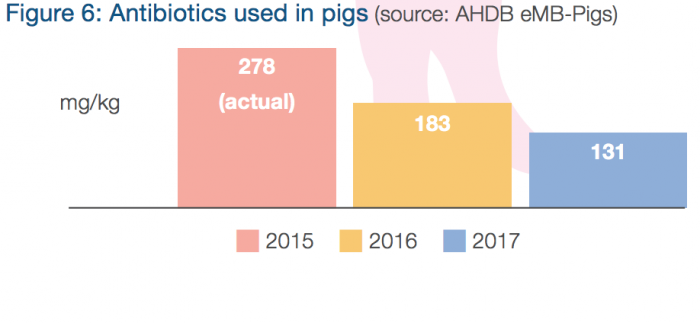The UK pig sector is on track to reach its antibiotic targets on the back of a ‘positive coordinated effort’ across the pig sector that has already resulted in large reductions in use, according to a report by RUMA’s Targets Task Force.
The ‘One Year On’ report is a follow up to the work of the group in 2017, when a leading farmer and veterinary surgeon from each sector – the NPA’s Richard Lister and the PVS’s Mark White for pigs – identified different starting points and potential for reduction in each species then worked with their respective sectors to gain support for the plans.
You can view the full report here
The update on pigs was very positive in light of the 50% overall reduction in usage since antibiotic use recording started in 2015 and significant reductions in usage of Highest Priority Critically Important Antibiotic (HP-CIA) antibiotics, which is now down to an extremely low level.
With a 2017 figure of 131mg/PCU compared with 278mg/PCU in 2015, the reductions are in line with the RUMA targets set last and the UK pig sector remains committed to achieving the target of 99PCU/mg by 2020, the report said.
“While further reductions are needed – and wanted by the sector – emphasis must now move towards achieving sustainable levels of antibiotic use. Antibiotics are a necessary tool to treat and control pig disease and a zero level of antibiotic use could seriously compromise animal welfare and therefore, it should not be expected that the pig sector will completely eliminate all use of antibiotics,” the report said.
“For this reason, the sector is working to ensure antibiotics are used optimally, not minimally. This means the correct antibiotic, at the correct dose, for the correct duration, to the correct animal(s) by the correct route. The sector welcomes the industry-wide approach to tackling this issue and is confident that it will achieve the ambitious targets while safeguarding animal welfare.”
Reaching the target will require continued and consistent actions from veterinary surgeons and producers, however. While the 2017 usage data showed great progress by the industry, it is likely that most of the easy wins have been secured, the report said.
“We will need to tackle specific concerns on-farm as well as industry-wide issues. This includes tackling endemic diseases within the UK pig herd,” the report said.
Commenting on what is needed to drive further growth, the report highlighted Improvements to biosecurity and the infrastructure of pig buildings to improve the overall health of pigs, better use of diagnostics and surveillance data and collaboration between farmers and veterinary surgeons to facilitate better disease control. Finally, to ensure that pig welfare is maintained, continued monitoring of indicators is vital to notify any changes to treatment regimes, the report said.
Reaction
RUMA’s secretary general Chris Lloyd said this new review showed transparency and accountability with which each sector is addressing its targets. “The UK farming industry has already achieved reductions of 40% in sales of antibiotics over the past five years and is one of the lowest users of antibiotics in Europe,” he said.
NPA senior policy advisor Georgina Crayford said the data highlighted the commitment of pig producers and vets to ensuring responsible use of antibiotics in pigs.
“The challenge now is for the pig sector to continue delivering against targets set by the RUMA Targets Task Force, and to ensure that the reductions in antibiotic use are sustainable, by ensuring they are supported by better control and prevention of disease,” she said.




